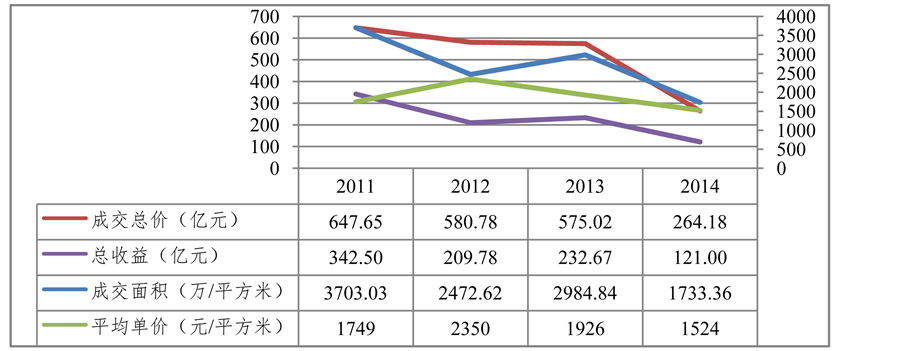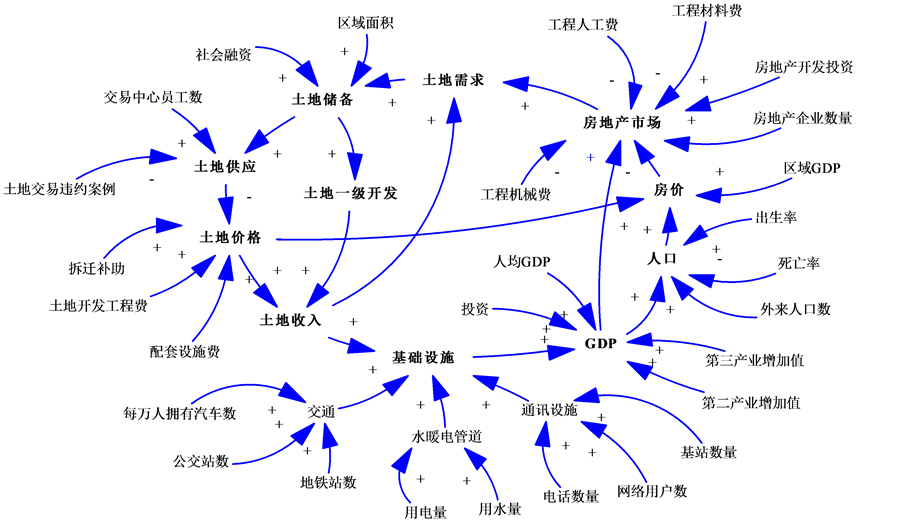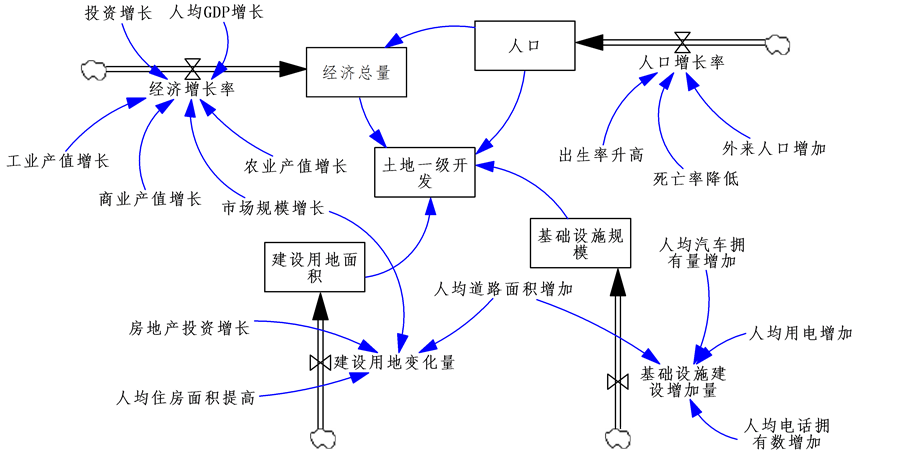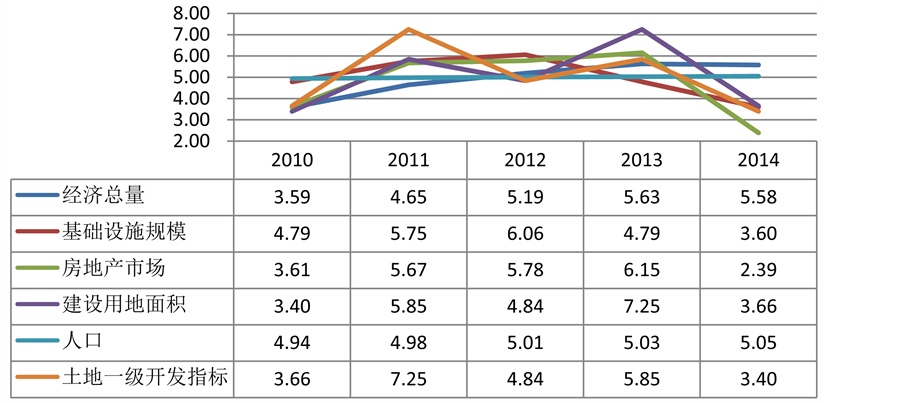1. 引言
现阶段房地产开发对国民经济有着极大的影响,而土地一级开发是房地产开发行业的上游产业,直接影响着房地产开发。目前,政府的税收有很大一部分来自于土地,土地一级开发对政府的财政收入有着很大的影响,土地财政等问题,和政府的财政风险有着密切的联系。不可否认,经过多年的发展,土地一级开发已经暴露出越来越多的问题,如政府过度依赖土地财政等,所以对土地一级开发进行优化是十分必要的。
2. 沈阳土地一级开发的模式与现状
随着沈阳城市的快速发展,房地产等行业的不断升温,沈阳城市土地一级开发得到了长足的发展,其重要性日趋明显。经过多年的发展,沈阳市的土地一级开发日趋完善,并为沈阳的城市建设作出了重要贡献。但不可否认,目前沈阳市的土地一级开发仍存在较多的问题,并且一些重要作用并没有得到充分的发挥。
2.1. 土地一级开发的概念与模式
土地开发可以分为土地一级开发与土地二级开发。土地一级开发是指由政府或其授权委托的开发主体实施,通过征地、拆迁、安置、补偿,使一定范围内的土地达到符合建设的条件,然后对其进行有偿出让或转让的行为 [1] 。土地二级开发则是土地使用者将可以转让的土地进行交易的过程,是指土地使用权的转让或再转让 [2] 。
因而,土地一级开发是“生地”开发成为“熟地”的过程,能够形成增量土地。而土地二级开发则是土地使用权的转让过程。土地一级开发目前主要有四种模式:
一是政府主导模式。即完全由政府建立的土地储备中心或国有控股或参股企业进行土地一级开发;
二是市场化运作但由政府所主导。由政府进行公开的招标,开发企业承担土地一级开发,然后交还政府出让,政府返还其成本和约定比例的一级开发利润;
三是完全市场运作模式。政府将“生地”出让给土地一级开发公司,由土地一级开发公司进行拆迁、补偿等,然后进行土地使用权的转让;
四是由政府与企业合作开发。企业与政府合作成立股份公司进行土地一级开发,而土地收益则由开发企业与政府按照一定比例进行分配。
目前沈阳土地一级开发属于政府主导的市场化模式,沈阳市的土地储备中心作为储备主体,投资方提供收储资金,最后由市土地交易中心依法组织土地出让,市土地储备中心向市财政局申请返还成本,并拨付给投资方。
2.2. 土地一级开发的目标与成本
2.2.1. 土地一级开发的目标分析
土地一级开发的最终目的是形成可用于工程建设的土地,期间伴随着城市拆迁或农村土地征用等环节。因而,土地一级开发的首要目标是如何高效的将“生地”开发建设成为“熟地”。并在对“熟地”出让的过程中,使土地一级开发对房地产市场以及城市经济等的重要作用得以体现。土地资源特别是城市土地资源一直是十分宝贵的不可再生资源 [3] 。因而,将土地一级开发的重要作用得到充分的发挥,是十分必要的。
2.2.2. 土地一级开发成本的组成
目前土地一级开发成本一般包括:1) 征收以及拆迁的补偿费;2) 收购、收回和置换过程中的补偿;3) 基础设施建设费用;4) 土地交易费用;5) 贷款利息;6) 审计、律师、工程监理等费用,不可预见费等其他支出。
沈阳土地一级开发的项目成本目前主要由房屋征收或征地拆迁成本、基础设施成本、财务成本等三部分构成。其中征地、拆迁费用所占土地一级开发总成本比重最大,一般占据土地一级开发成本的70%以上。
2.3. 沈阳土地一级开发的现状与问题
2.3.1. 沈阳土地一级开发现状
为了更好地实现城市规划,遵循城市建设的客观发展规律,改变过去“摊大饼”的老路。近几年来,沈阳市在土地一级开发方面进行积极探索,使其更加规范化和市场化。沈阳土地一级开发的发展,加速了沈阳城市化进程,为沈阳城市经济的快速发展提供了重要的支撑。
沈阳作为东北经济文化中心有着不同于其他城市的特点:在土地一级开发中老城区所占的比重较高;且由于地处平原,沈阳向外扩展也相较容易,土地一级开发存在一定的盲目性;寒冷的自然条件也影响到了沈阳的土地一级开发,相较于南方地区,作物一年一熟使得土地补偿会更少。
图1为近年来沈阳土地市场概况。从图中可以看出,沈阳土地市场2011至2013年为供地高峰期,进入2014年,成交面积下降幅度较大,土地出让面积逐渐回归理性;由于受到三环内外出让地块增减影响,成交单价波动幅度较大;成交总价逐年减少;由于拆迁成本的逐年攀升、收储难度逐渐加大,使得土地总收益逐年减少。2014年是沈阳土地和房地产市场发展的一个重要转折点。
2.3.2. 沈阳土地一级开发存在的问题
1) 过度依赖土地财政
近几年,土地出让金收入占沈阳地方财政收入的30%左右,给地方财政带来了巨大的贡献。土地一级开发的收益间接地推动了沈阳地方经济的发展。但是,过度依赖于土地收益,不但不利于土地一级开发的可持续发展,且使得地方政府的财政收入存在着一定的风险 [4] 。

Figure 1. The overview of Shenyang land market
图1. 近年沈阳土地市场概况
2) 城乡土地政策不统一
目前我国的土地政策是城市土地归国家所有,而农村土地归集体所有。城乡土地政策的脱节,导致城乡土地市场连接不完善,不利于土地一级开发的发展 [5] 。而且,农村集体所有土地,目前并没有出台相应的使用权征收管理办法。城乡土地政策不统一,导致农民的合法权益无法得到充分的保障,使农村的土地资源未能得到充分的应用。
3) 土地征收成本逐年上涨
土地征收成本一直占土地一级开发成本中较大比重,且由于国家征收政策的出台,以及人们对拆迁的意识提高,存在“拆迁难”、“拆迁贵”的情况,使得土地征收成本水涨船高。土地征收成本逐年上涨,将导致城市地价的不断攀升。
4) 融资渠道单一
由于土地一级开发的资金需求量大,融资问题是阻碍土地一级开发的重要因素。当前沈阳土地一级开发的融资渠道主要以地方政府财政拨款和银行贷款为主,渠道相对单一,而通过股权合作、信托等新的融资方式解决资金问题相对较少。由于缺乏灵活有效的融资方式,严重制约了土地一级开发的规模。
3. 沈阳土地一级开发综合效果评价
3.1. 系统动力学模型的建立
系统动力学以反馈控制理论为基础,以计算机仿真技术为手段,主要用于研究复杂系统的结构、功能与动态行为之间的关系。系统动力学目前已经广泛应用于社会、经济、管理、资源环境等诸多领域。土地一级开发的影响因素较多且相互之间关系繁杂,由于系统动力学可以更加整体性地了解系统,并分析系统各部分之间的相互作用。故此,本文基于系统动力学模型,借助Vensim软件对沈阳市土地一级开发现状进行实证研究 [6] 。
3.1.1. 变量说明
土地一级开发主要与当地经济发展、基础设施建设、房地产市场、城市化率有关。各因素之间相互影响,构成了一个内部体系。本文根据反应土地一级开发系统的若干相关因素,如土地储备、土地市场、城市经济、城市房地产市场,并考虑建立模型的需要,选取了28个相关状态变量、流量、存量,作为模型建设的依据 [7] 。表1列出了相关变量及其在土地一级开发系统中所代表的意义。
表1. 影响因素
3.1.2. 因果关系图
确定系统的边界后,根据系统内各个因素的分析,可以得到系统因果关系图。考虑土地一级开发各因素之间的促进和制约关系,就可以得到各因素之间的因果关系。然后根据已经选取的沈阳市土地一级开发的相关因素之间的因果关系,同时根据相关数据的一些具体情况,就可以基于系统动力学仿真软件VENSIM PLE建立土地一级开发与相关因素的关系环图(图2) [8] 。图2中“+”表示正相关影响,“−”表示负相关影响。
3.1.3. 系统流图
根据图2中各个因素之间的关系,选取基础设施规模、建筑用地面积、经济总量、人口作为状态存量,表征状态变量土地一级开发状况指标 [9] 。现运用VENSIM PLE建立模型流图如图3所示。图3中的变量是原数据经过归一化处理后形成的状态变量。
3.2. 模型分析
3.2.1. 模型因果反馈回路分析
根据已经建立的系统动力学模型,可以得到土地一级开发系统的主要反馈回路有:
1) 土地一级开发→(+)土地收入→(+)基础设施建设→(+)GDP→(+)房地产市场→(+)土地需求→(+)土地储备→(+)土地一级开发。这是一个正反馈回路。土地一级开发会增加政府财政收入,从而提高基础投资建设,进而促进经济建设,最终导致房地产市场的发展。发展的房地产市场会导致土地需求的增加,从而促进土地一级开发的发展。
2) 土地一级开发→(+)土地收入→(+)基础设施建设→(+)GDP→(+)人口→(+)房价→(-)房地产市场→(+)土地需求→(+)土地储备→(+)土地一级开发。这是一个负反馈回路。土地开发促进经济增长后,会导致城市人口的增长,进而引发房价的上涨,从而阻碍了房地产市场的发展,最终对土地一级开发起到了制约作用。

Figure 2. The relationships of Shenyang first-class development
图2. 沈阳土地一级开发关系环图

Figure 3. Flow chart of Shenyang first-class development
图3. 沈阳土地一级开发模型流程图
3) 土地一级开发→(+)土地收入→(+)土地需求→(+)土地一级开发。这是一个正反馈回路。土地一级开发的发展,会导致土地收入的增加,从而引发更多的土地需求,最终促进了土地一级开发的发展。
4) GDP→(+)房地产市场→(+)土地需求→(+)土地储备→(+)土地供应→(-)土地价格(+)土地收入→(+)基础设施建设→(+)GDP。这是一个负反馈回路。城市经济的增长促进了房地产市场的发展,增加了土地需求以及土地供应,但土地供应上涨导致土地价格下降,政府财政收入不足,会导致经济发展受限。
我们最终想要的结果是土地市场、土地开发、城市经济以及城市房地产市场的健康发展。由反馈回路可以知道,这几个因素之间是相互促进并相互制约的。尤其是土地开发与房地产市场,他们之间有着更大的直接或者间接的相互联系。房地产的发展,会导致土地需求增加,而土地收入增加,最终也会促使房地产市场的发展。而它们之间相互联系并相互制约的主要两个因素是地价与房价,地价与房价最终影响了土地一级开发与房地产市场的需求上涨或下降,因此对这两个因素的管控是十分必要的。
3.2.2. 模型模拟分析
基于建立的土地一级开发系统模型进行模拟,图4为土地一级开发发展环境的模拟结果。从结果可以看出,对沈阳土地一级开发影响较大的因素为基础设施规模、建筑用地面积以及房地产市场。可以看到沈阳土地一级开发状况波动幅度较大,这几年呈现中间高两头低的状况。这是由于受到2013年全运会与中国经济新常态双重影响的结果。可以看到,由于全运会的影响,2013年前,沈阳的基础设施建设以及土地一级开发都处于一个较高位的状况。由于新常态的调整,2014年,沈阳土地一级开发的状况明显不乐观 [10] 。
3.3. 总结
通过对模型的分析,可以发现,土地一级开发与房地产市场之间最具有关联性。土地一级开发与房地产市场之间有着很强的相互联系。房地产市场对土地一级开发有着很大的影响。同样,土地一级开发,对房地产市场有着很强的导向作用。通过对土地市场的调控,政府可以有效的对房地产市场进行调整。
土地一级开发发展至今,已经日渐成熟,但不可否认仍存在一些问题,比如政府没有充分的对土地一级进行相应的规划与管理,政府还没有完全利用土地一级开发的相关作用,以及目前城乡土地市场为二元制等。
4. 沈阳土地一级开发目标优化及对策建议
4.1. 沈阳土地一级开发的目标优化
土地一级开发已经发挥了很大的作用。土地一级开发的目标是调整产业结构、优化资源配置和促进城乡经济协调发展。当前,沈阳土地一级开发已经得到了极大的改进,但仍然存在着一些不利于其发展

Figure 4. Simulation results of Shenyang first-class development
图4. 沈阳土地一级开发状况模拟结果
的因素。因而,应该对土地一级开发存在的问题进行改进,并对其目标进行优化,使其能更加协调于社会经济与房地产市场的发展。
4.2. 沈阳土地一级开发优化建议
1) 调整土地一级开发产业结构
要调整土地一级开发的产业结构,首先必须坚持政府主导。政府是土地—级开发的调控者,也是市场的监管者,而且还是公众利益的代表者,所以政府应该在土地一级开发过程中发挥主导作用;其次应该完成市场化。市场主要功能是资源优化配置、优化经营主体,政府应建立起市场公正、透明、可以量化的规则。
2) 优化资源配置
土地一级开发应该与城市的发展相结合,利用土地一级开发,可以对城市资源的配置进行优化。将土地一级开发与经济适用房、公共服务设施、城市防灾系统等内容相结合,并优先落实教育、医疗等公共服务设施,以及城市防灾等公共设施的土地规划。
3) 促进城乡经济协调发展
利用土地一级开发,进一步加强农村建设,协调城乡经济发展。立足于农村发展,促进新农村建设,并以此做好农村土地一级开发。更好地解决城乡中低收入居民住房问题创造条件,为改善城乡居民生活质量提供有利条件。
4) 合理进行土地一级开发规划,降低土地征收成本
要使土地一级开发有计划、有节奏地进行,首先要做好土地一级开发的规划。土地一级开发是指从立项、拆迁直到最终开发成“熟地”出让的整个过程,具有参与方多、步骤繁杂、工期长等特点。因而事先做好开发规划是十分必要的;同时,通过制定合理的拆迁规划,在积极了解并满足拆迁户基本利益的基础上,合理地降低土地征收成本。
5) 加强出让后的动态管理
政府应加强出让之后的动态管理。要想充分利用土地一级开发的行业管控作用,就不能单纯以卖地为目的。更应该注重出让之后对行业的管控,合理规范开发企业的行为,并就环境保护等一些具体事项对企业进行要求。
6) 实现土地一级开发的房地产市场导向作用
作为房地产业的重要一环,政府可以在土地交易中对开发企业提出一些硬性要求,以此来实现土地一级开发的导向作用。例如,对“地下空间开发”等可以缓解城市空间不足的措施、实现开发建设中的环境保护措施,政府可在土地交易中设立硬性要求。
7) 统一城乡土地市场
土地一级开发一般发生在城乡结合部等土地资源相对充足的地区,这些地区往往存在着城市土地与农村土地两种所有权。与城市土地国家所有不同,农村土地归集体所有。不同的制度必然导致城乡土地市场的脱节,严重制约了土地市场的发展。因而,应该对城乡土地制度进行多规合一,并统一城乡土地市场。积极引导农村土地资源的合理应用,保障农村拆迁户的利益。